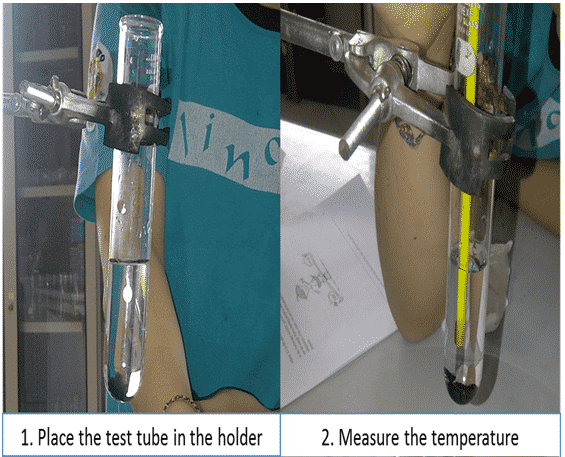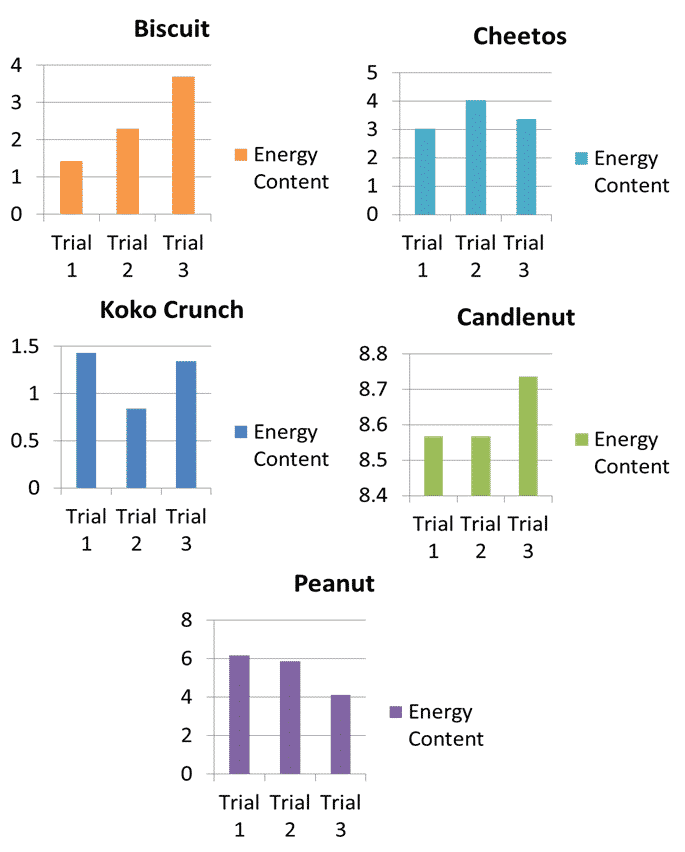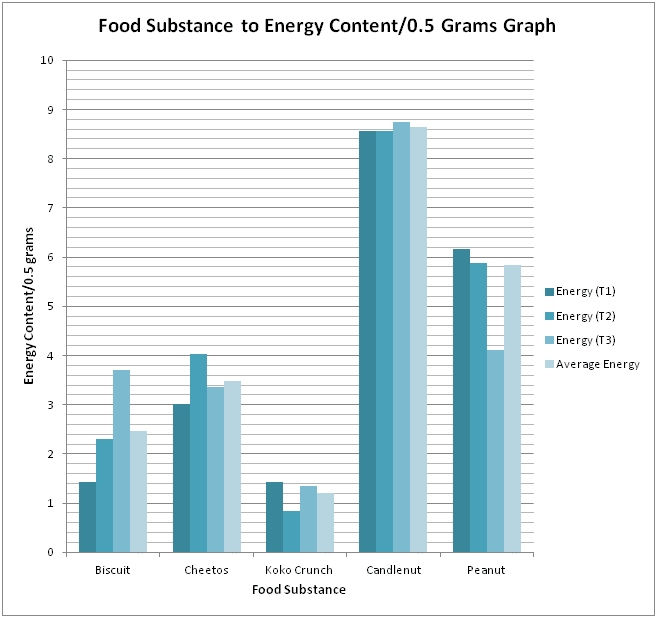Hypothesis
If the change in temperature is greater when the water is heated with the use of the fire caught by the food substance, then the energy content in the food substance is higher because the heat energy is greater, since the heat energy is absorbed by the water when the fire is kept under the test tube containing water.
The formula indicates that if the change in temperature is greater when the mass of the substances and the volume of water are constant, then the heat energy is higher.
The conclusion drawn by my hypothesis is:

Apparatus
- Test Tube
- Measuring Cylinder
- Laboratory Thermometer
- Water
- Needle with Handle
- Scalpel (for cutting the substances into exactly 0.5 grams)
- Test tube holder
- Burner
- The following substances are the 5 different food items that are used to conduct the experiment, the substances used are:
i. Biscuit
ii. Koko Crunch
iii. Cheetos
iv. Peanut
v. Candle nut
Variables
- Independent Variable: Heat energy of the food substance used.
- Dependent Variable: Temperature change in the water/Amount of energy absorbed.
- Controlled Variable: Amount of water, Temperature of surroundings, Type of needle used, Temperature of water.
Manipulation
- Independent Variable: As we vary the food items that we use, their heat energy/ they themselves become the independent variable.
- Dependent Variable: The change in temperature/ Heat energy absorbed is varied as the heat energy of the substance is varied.
- Controlled Variable: The temperature is not varied in any case or does not depend on anything during this experiment, the amount of water equals 20ml in each trial of an experiment for each food substance.
Procedure
- Measure 20ml water in the measuring cylinder and pour it into the test tube.
- Place the test tube in the holder and lock it tight.
- If the food substance measures 0.5 grams on the electrical balance, then use the substance, otherwise use the scalpel to divide it into smaller pieces and make sure it measures exactly 0.5 grams.
- Measure the initial temperature of the water using the thermometer
- Poke through a food substance measuring 0.5 grams using the needle with the handle.
- Turn on fire on the burner.
- Set the food substance on the needle to fire on the burner.
- Once the food substance starts to burn, place it under the test tube so the water inside it can absorb heat.
- Measure the temperature change in the water using the thermometer.
- Measure the energy content in the food item by using the following formula:

Set up


Results
| Biscuit | Initial Temp (ᵒC) of Water | After Burn Temp(ᵒC) Water | Mass (g) Biscuit | Energy Content of Biscuit (kJ) |
| Trial 1 | 26 | 35 | 0.53 | 1.426 |
| Trial 2 | 27 | 41 | 0.51 | 2.305 |
| Trial 3 | 27 | 49 | 0.51 | 3.696 |
| Koko Krunch | Initial Temperature of Water (ᵒC) | After Burn Temperature (ᵒC) Water | Mass (g) of the Koko Crunch | Energy Content (kJ) |
| Trial 1 | 25 | 33.5 | 0.5 | 1.428 |
| Trial 2 | 25 | 30 | 0.5 | 0.840 |
| Trial 3 | 25 | 33 | 0.5 | 1.344 |
| Cheetos | Initial Temperature of Water (ᵒC) | After Burn Temperature of Water (ᵒC) | Mass (g) of the Cheetos | Energy Content of Cheetos (kJ) |
| Trial 1 | 26 | 44 | 0.5 | 3.024 |
| Trial 2 | 25 | 49 | 0.5 | 4.032 |
| Trial 3 | 25 | 45 | 0.5 | 3.360 |
| Candle nut | Initial Temperature of Water (ᵒC) | After Burn Temperature of Water (ᵒC) | Mass (g) of the Candlenut | Energy Content of Candlenut (kJ) |
| Trial 1 | 25 | 76 | 0.5 | 8.568 |
| Trial 2 | 28 | 79 | 0.5 | 8.568 |
| Trial 3 | 28 | 80 | 0.5 | 8.736 |
| Peanut | Initial Temperature of Water (ᵒC) | After Burn Temperature of Water (ᵒC) | Mass (g) of the Peanut | Energy Content of the Peanut (kJ) |
| Trial 1 | 28 | 64 | 0.49 | 6.171 |
| Trial 2 | 25 | 60 | 0.5 | 5.880 |
| Trial 3 | 27.5 | 52 | 0.5 | 4.116 |

Average Results
| Food Item | Energy T1(kJ) | Energy T2(kJ) | Energy T3(kJ) | Average Energy (kJ) |
| Biscuit | 1.426 | 2.305 | 3.696 | 2.476 |
| Cheetos | 3.024 | 4.032 | 3.360 | 3.472 |
| Koko Crunch | 1.428 | 0.840 | 1.344 | 1.204 |
| Candle nut | 8.568 | 8.568 | 8.736 | 8.652 |
| Peanut | 6.171 | 5.880 | 4.116 | 5.839 |

Discussion of Results
The least energy as the graph shows is in the Cereal (Koko Crunch). It contains about 1.2 kJ of Average Energy. Candlenut contains the highest amount of energy in the 5 items used during the experiment possessing energy of approximately 8.6kJ.
The trials of the Biscuit show increasing energy from T1 to T3, causing the Average Energy to be higher than the energy obtained in T1 and T2 but lesser than T3. The results of Candlenut show a similar pattern and Peanuts have an opposite pattern.
The results of Cheetos show a pattern of results being T1 (Least) – T2 (Highest) – T3 (Lesser than Highest and Higher than Least). The Average Energy in this case is just a bit higher than the T3. The Koko Crunch shows the opposite pattern and therefore the Average Energy observed is higher than T3.
The trials of Biscuit and Peanut show high variation, this shows the inaccuracy in the results that can be explained by evaluating the method used.
Conclusion
My results completely agree with my hypothesis that when the temperature change is greater, the energy content is higher. My hypothesis states:
If the change in temperature is greater when the water is heated with the use of the fire caught by the food substance, then the energy content in the food substance is higher because the heat energy is greater, since the heat energy is absorbed by the water when the fire is kept under the test tube containing water.
The formula indicates that if the change in temperature is greater when the mass of the substances and the volume of water are constant, then the heat energy is higher.
If compared to my results, I can vouchsafe that my hypothesis agrees with my results.
Evaluation
The experiment was done with the best method possible in the lab with the provided equipment. The accuracy could be increased by:
- Use a calorimeter to insulate the test tube to prevent loss of heat energy.
- Use a digital thermometer for accurate readings of temperature.
- Prevent the carbon coating that is formed on the test tube when a substance is burnt as it forms insulation.
- Try to have a handle made out of wood for the needle as metal conducts heat.
- Conduct more trials.
- Turn off the A/C and perform the experiment at room temperature.
- Use exactly 0.5 grams of food substances. Prevent even the minute errors.

Lovely, just lovely. A true champion in the field of science.
what is the name of this experiment?
Extremely useful!!!
AMAZING EXPERIMENT! schoolwork helper, thank you for helping me understand calories
what is left at the end of the experiment when the foods are completely burnt?
you used 5.839 as your average for the peanut, it should be 5.389. 🙂
Calculation of energy content of peanut
What formula do you use to calculate the amount of Joules?
Energy released from food ( gram) = (Mass of water x temp rise x 4.2g) / Mass of food sample
Really great .. thank you so much
Thanks a lot this helped me with my plan and design lab.Thanks much really appreciate it 😊😊
Thanks a lot!! I really appreciate it!!!! It helped me with my homework and to be frank, it fulfilled my requirements!! Please keep it up!! 😉